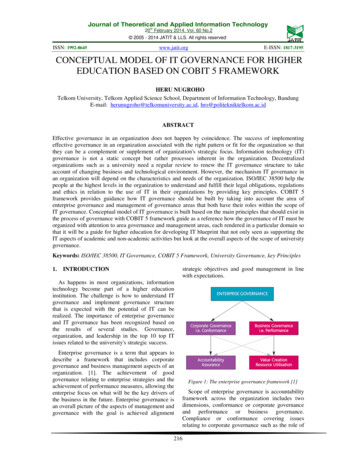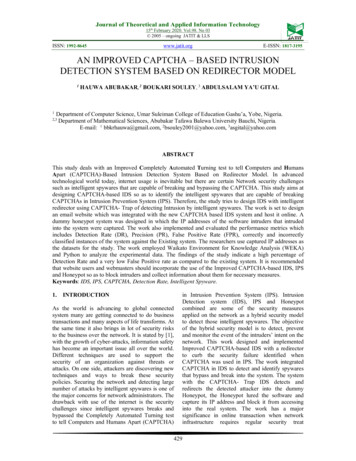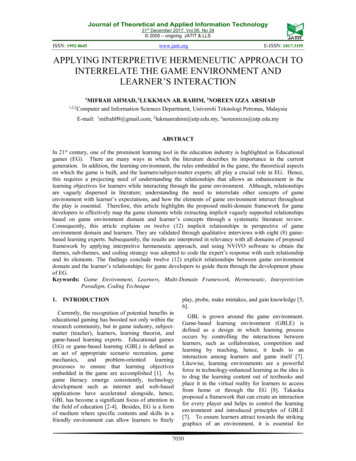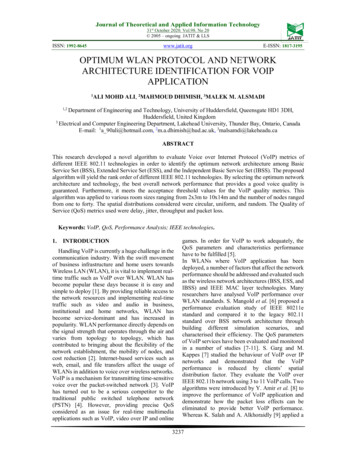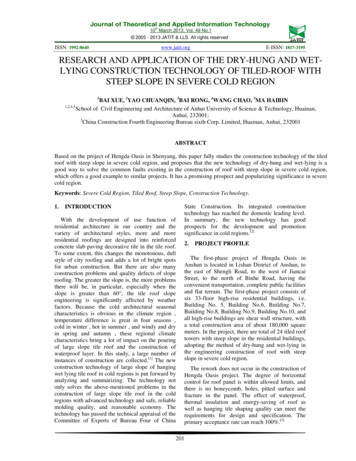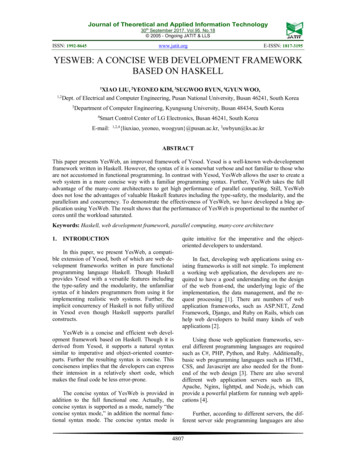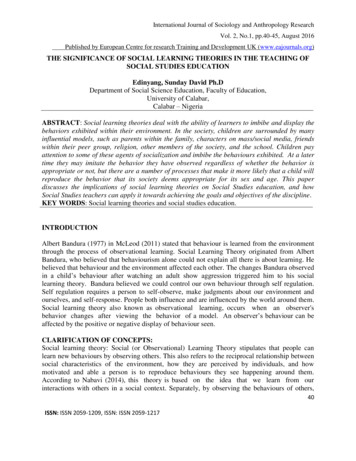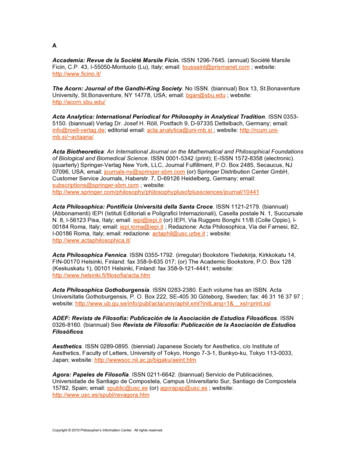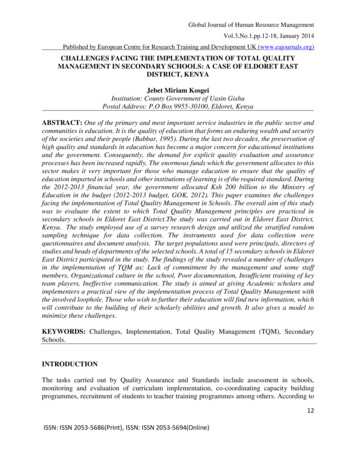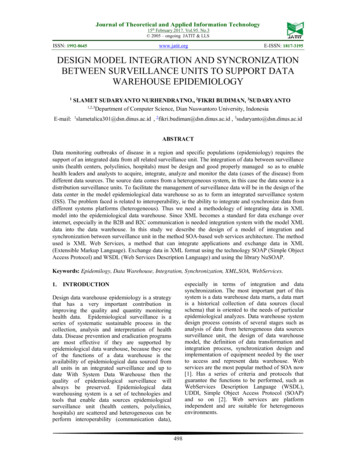
Transcription
Journal of Theoretical and Applied Information Technology15th February 2017. Vol.95. No.3 2005 – ongoing JATIT & LLSISSN: 1992-8645www.jatit.orgE-ISSN: 1817-3195DESIGN MODEL INTEGRATION AND SYNCRONIZATIONBETWEEN SURVEILLANCE UNITS TO SUPPORT DATAWAREHOUSE EPIDEMIOLOGY1SLAMET SUDARYANTO NURHENDRATNO., 2FIKRI BUDIMAN, 3SUDARYANTO1,2,3Department of Computer Science, Dian Nuswantoro University, IndonesiaE-mail: 1slametalica301@dsn.dinus.ac.id , 2fikri.budiman@dsn.dinus.ac.id , 3sudaryanto@dsn.dinus.ac.idABSTRACTData monitoring outbreaks of disease in a region and specific populations (epidemiology) requires thesupport of an integrated data from all related surveillance unit. The integration of data between surveillanceunits (health centers, polyclinics, hospitals) must be design and good properly managed so as to enablehealth leaders and analysts to acquire, integrate, analyze and monitor the data (cases of the disease) fromdifferent data sources. The source data comes from a heterogeneous system, in this case the data source is adistribution surveillance units. To facilitate the management of surveillance data will be in the design of thedata center in the model epidemiological data warehouse so as to form an integrated surveillance system(ISS). The problem faced is related to interoperability, ie the ability to integrate and synchronize data fromdifferent systems platforms (heterogeneous). Thus we need a methodology of integrating data in XMLmodel into the epidemiological data warehouse. Since XML becomes a standard for data exchange overinternet, especially in the B2B and B2C communication is needed integration system with the model XMLdata into the data warehouse. In this study we describe the design of a model of integration andsynchronization between surveillance unit in the method SOA-based web services architecture. The methodused is XML Web Services, a method that can integrate applications and exchange data in XML(Extensible Markup Language). Exchange data in XML format using the technology SOAP (Simple ObjectAccess Protocol) and WSDL (Web Services Description Language) and using the library NuSOAP.Keywords: Epidemilogy, Data Warehouse, Integration, Synchronization, XML,SOA, WebServices.1.especially in terms of integration and datasynchronization. The most important part of thissystem is a data warehouse data marts, a data martis a historical collection of data sources (localschema) that is oriented to the needs of particularepidemiological analyzes. Data warehouse systemdesign process consists of several stages such asanalysis of data from heterogeneous data sourcessurveillance unit, the design of data warehousemodel, the definition of data transformation andintegration process, synchronization design andimplementation of equipment needed by the userto access and represent data warehouse. Webservices are the most popular method of SOA now[1]. Has a series of criteria and protocols thatguarantee the functions to be performed, such asWebServices Description Language (WSDL),UDDI, Simple Object Access Protocol (SOAP)and so on [2]. Web services are platformindependent and are suitable for heterogeneousenvironments.INTRODUCTIONDesign data warehouse epidemiology is a strategythat has a very important contribution inimproving the quality and quantity monitoringhealth data. Epidemiological surveillance is aseries of systematic sustainable process in thecollection, analysis and interpretation of healthdata. Disease prevention and eradication programsare most effective if they are supported byepidemiological data warehouse, because they oneof the functions of a data warehouse is theavailability of epidemiological data sourced fromall units in an integrated surveillance and up todate With System Data Warehouse then thequality of epidemiological surveillance willalways be preserved. Epidemiological datawarehousing system is a set of technologies andtools that enable data sources epidemiologicalsurveillance unit (health centers, polyclinics,hospitals) are scattered and heterogeneous can beperform interoperability (communication data),498
Journal of Theoretical and Applied Information Technology15th February 2017. Vol.95. No.3 2005 – ongoing JATIT & LLSISSN: 1992-8645www.jatit.orgE-ISSN: 1817-3195Figure 2. Integration Of XML Document Within AData Warehouse EpidemiologyXML web srvices is a software system designedto support interoperability in machine to machineinteractions in a network [9]. Interaction is donethrough a specific protocol. Thus the ability ofweb services can be increase the ability of the webto communicate and share information and datawith the pattern of program-to-program. With thedesign of XML web services will can be integratethe system, programming language support,database and operating system platform that isdifferent from the protocol http (HypertextTransfer Protocol). Thus dbms application andheterogeneous between surveillance unit cancommunicate with the system of epidemiologicaldata warehouse. The purpose of this study was toanalyze, design, system integration andsynchronization between surveillance unit with thehealth service system in a prototype modelepidemiological data warehouse.Figure 1. SOA-Based Web Services ArchitectureSOA is a leading integration method and theheterogeneous system environment architectureframework [3]. The basic idea of SOA is servicescored and integrate information resources onservice standards, enabling reconfiguration andreuse of information resources [5]. SOA is respiteservices that can be combined with architectureservices [6,7]. Communication services with asimple interface definition and precision that doesnot involve programming interface andcommunication models. There are three parts SOAarchitecture based on web services: servicesprovider, registry services, consumer services [8].Consumer service providers and each refers to thesystem of external and internal corporate systems.As a solution can be divided into three tierarchitecture, the application tier, services tier andresource tier. Resource tier contains all sorts ofdatabases of the MIS wich need to be integrated.Services tier is the core of the solution, stration, discovery, invocation and the datamapping module. Application tier consists of theapplication client of MIS ind information portal.XML is an emerging Internet applications orientedmarkup language for documents contains bothcontent and structure. Xml is extensible, platformindependent and easy to transfer in the network, soit is very suitable for describing information andthe data synchronaization and database integration.Figure 3. The Heterogenous Database IntegrationArchitecture1.1. Heterogenous Data Integration ProblemIntegration is the process of combining differentdata in different data sources, and provide userswith a unified view of the data [11]. Basically this499
Journal of Theoretical and Applied Information Technology15th February 2017. Vol.95. No.3 2005 – ongoing JATIT & LLSISSN: 1992-8645www.jatit.orgE-ISSN: 1817-3195inter-process communication on the use of dataand resources together.process through the development of an integratedsystem. Lazerini [11] characteristics of the systemas a data integration architecture based on a globalscheme and a set of data sources. The data sourcecontains data riel, while global scheme provides areconciliation, integration, and a virtual view ofthe basic sources of data. With global virtualglobal view, users can be gain access systemintegrated uniform data from different datasources. Two basic approaches are used betweenthe model of global schema and data sources (localscheme). The first Global-as-View (GAV) wherethe global schema as the data source [12]. Thesecond is the Local-as-View (LAV) in which eachdata source is defined as a view over the globalschema. Some of the problems related to theintegration of heterogeneity of data between datasources as a local schema with a global schema isschemamapping,thedatacleansing,transformation of data, the data reconsciliationproblem.2. EXPERIMENTAL2.1. Architecture Model Integration BetweenSurveillance UnitsIn the draft for a model of integration betweenapplications to be built with webs services is theintegration of epidemiological data fromsurveillance units health centers and hospitals.Where the surveillance unit that uses dbms anddifferent applications (My Sql and PostgreSQL).Access will be built in advance of the applicationcommunication occurs in two directions, whichthrough web services each surveillance unit willtake the local epidemiological data from thedatabase was changed into the form of a documentin a format specific parameters (SOAP Services).Then the web service to send and request accessbetween applications will continue to health ical data warehouse.1.2. HeterogenousDataSynchronizationProblemSinkronsai heterogeneous data directly relatedto the process of replication of data betweenheterogeneous databases. Data replication is theprocess of generating, producing, and maintaininga set of data in one or more locations [13]. ]. Datareplication between databases is very important tothe availability of the data up-to-date wheneverand wherever the data is needed. In terms ofcommunication and the timeliness of the datareplication process can be be synchronous orasynchronous. The process of data synchronizationis the process of transforming the current datastatus of the application system to otherheterogeneous systems and update the data tomaintain data consistency. Synchronization of dataas "a technical method that can Achieveconsistency of data from databases inheterogeneous multi-platform". Synchronization isalso a specially needs data integration to providereal-time consistency between local and globaldata sources through the update mechanism. Thus,data synchronization means that if there arechanges to the data on the local data source will benotified, or distributed to a datasource thatcorresponds to the domain ironmental changes will automatically performinter-system update. Synchronization can beclassified into uni-directional data synchronizationand bi-directional data synchronization. Some ofthe problems related to the data synchronization isFigure 4. Model Design Data Integration Between UnitsSurveillance In A Data Warehouse Epidemiological2.2. Design Model Integration Web ServicesBetween Units Surveillance.a). The integration between the systemsdepartment of population with health centersystem. The system of official of populationinformation will provide a service to health centersand hospitals. Here is the architectural integrationbetween the system of population with healthcenter system.500
Journal of Theoretical and Applied Information Technology15th February 2017. Vol.95. No.3 2005 – ongoing JATIT & LLSISSN: 1992-8645www.jatit.orgWeb Service Serverc). The integration between the hospital systemwith system health office. The integration betweenthe hospital information system with a systemallowing health office to monitor health officeepidemiology ddata sourced from hospitals, thefollowing is a systematic integration architecture.Web Service ClientDatabaseMysqlDatabaseMysqlt pasientabel pendudukPuskesmas aSis kependudukanXML SOAP RequestXML SOAP ResponseE-ISSN: 1817-3195INTERNETWeb Service ClientWeb Service ServerWeb ServerSistem KependudukanWeb ServiceServiceDinasKependudukanWeb ServerSistem Puskesmastabel survilenceDatabasePostgreSistem PuskesmasSistem Kependudukanlaporan penyakitDatabaseMysqldb rumahsakitdb dinkestabel pasienlaporan penderitaXML SOAP RequestFigure 5. Architecture Web Services IntegrationBetween The System Of Population With Health CenterSystemXML SOAP ResponseWeb ServerSistem Rumah sakitPopulation system also provides service to thehospital system that integrates both, the followingis the architectural integration between the systemof population with hospital systems.Web Service Serverdb rumahsakitXML SOAP RequestXML SOAP ResponseWeb ServerSistem Kependudukand). Integration between health center systems withsystem health office. Integration of health servicessystem will provide service to the health centerssystem, so that epidemiological surveillance dataeach case the disease will be able to monitor thehealth office. The following is a the architecture ofsystem integration between health office withhealth center system.tabel pasientabel pendudukINTERNETWeb ServiceServiceDinasKependudukanWeb ServerSistem Rumah sakitWeb Service ServerSistem Rumah sakitSistem KependudukanWeb Service ClientDatabaseMysqlFigure 6. Architecture Web Service Integration BetweenSystems Of Population With Hospital Systemsdb dinkesDatabaseMysqlIcd penyakitpuskesmas at penyakitXML SOAP Requestb). Integration between health center systems withsystem health office. Health center informationsystem will provide service to the healthdepartment, so the health department can receivedata from each recording of cases of the disease.The following is a system architecture integration.XML SOAP ResponseWeb ServerSistem DinkesWeb serviceServiceDinasKesehatanSistem DinkesWeb Service ClientWeb Service ServerSistem DinkesFigure 8. Integration Architecture Webservices HospitalSystem With System Health OfficeWeb Service ClientSis kependudukanWeb ServerSistem DinkesWeb Service LaporanRumah SakitSistem Rumah eb ServerSistem PuskesmasSistem PuskesmasFigure 9 Integration Of Web Services ArchitectureSystem Health Office With System Health Centerst stat penyakitDatabaseMysqllaporan penyakitpuskesmas aDatabaseMysql2.3. Web Services DesignAfter the design phase of web servicesintegration model between several surveillanceunits, then the next stage is to perform theimplementation of the XML programming on eachweb design services related to system integrationAtar surveilasn related units. Some of web designservices are as follows:a). Web services system of reporting health centersto integrate with system health office.db dinkest pasienlaporan penderitaXML SOAP RequestXML SOAP ResponseWeb ServerSistem PuskesmasWeb Service LaporanPuskesmasSistem PuskesmasINTERNETWeb ServerSistem DinkesSistem DinkesFigure 7. Integration Of Web Services ArchitectureHealth Center System With System Health Office501
Journal of Theoretical and Applied Information Technology15th February 2017. Vol.95. No.3 2005 – ongoing JATIT & LLSISSN: 1992-8645www.jatit.orgE-ISSN: 1817-3195Figure 10. Web Services For Health Centers SystemFigure 12. Web Services For Hospital SystemFigure 13 Example WSDL Web Services HospitalSystem2.4. Mapping Rule s scheme mainly deal with theproblem of the transformation and exchange ofdata. Mapping rules are middle-ware that isindependent and not influenced from variousplatforms. Mapping rules can also be appliedschema in format and values of query results.Figure 11. Example WSDL Web Services HealthCenters Systemb). Web services for hospital reporting systemintegrated with health office system.502
Journal of Theoretical and Applied Information Technology15th February 2017. Vol.95. No.3 2005 – ongoing JATIT & LLSISSN: 1992-8645www.jatit.orgE-ISSN: 1817-3195Figure 14. Example Mapping Value Schema FromQueryFigure 15. Example GAV As Mediator SchemaSynchronization Between Local And Global Schemes2.5. Design Gav (Global as View) as a mediatorschema synchronization.Is a global schema as mdiator that serve to helpsynchronize data items in the form of unitsurveilas local schema LAV (Local as View). Themediator scheme is temporary shelter datareception with local schema defines techniques(reformulated) to match the structure of the globalscheme. Scheme mediator also helps the processof reformulating the query with the data requestthrough the local schema global scheme.3.RESULTS AND DISCUSSIONPrototype integration of the data center that wasdeveloped at health office surveillance is anintegration of two units, namely health centers andhospitals. By designing XML Web Services datafrom two units of surveillance data can be unifiedinto a single integrated system (data warehousemodel) although derived from the system anddbms different applications (multi-platform). Thefigure below shows the number of data reportsinformation derived from epidemiologicalsurveillance units (health centers and hospitals)both daily (w1), weekly (w2) or monthly (LB1).Figure 16 Monitoring And Analysis Of The Results OfThe Integration Of Data Center Epidemiological DataOn Health Office503
Journal of Theoretical and Applied Information Technology15th February 2017. Vol.95. No.3 2005 – ongoing JATIT & LLSISSN: 1992-8645www.jatit.org4.For monitoring epidemiological data transmissionfrom the surveillance unit shipment data can be besynchronized from each surveillance unit each daycontinuously, so that it can automatically in themonitoring. With daily monitoring of this systemwill can be ensure the surveillance unit anywherethat does not perform epidemiological datatransmission so that it can be done a certain action,it is very important to monitor the outbreak,particularly for infectious disease outbreaks.E-ISSN: 1817-3195CONCLUSIONIn this research has been done web designdevelopment servives with XML and hasconducted testing of prototype data center wherethe health agency epidemiological data sourcesepidemiology derived from epidemiological datareporting health centers and hospitals with a dailyformat (W1), weekly (W2) and monthly (LB1).From the results of prototype testing of theepidemiological data center, web design servicesuccessfully integrated reporting system of unitssurveilas although epidemiological data sourcescome from different applications and dbms(MySQL and PostgreSQL) as well as differentdata structures. This shows the communicationprotocol middleware web service that is able toexchange epidemiological data as messege byutilizing HTTP protocol via a computer networkbetween web-based and database apikasi betweensurveillance unit with database data center lance unit with web technology services incomputer networks also showed communicationbetween the provider and the services requestersevices can be used for monitoring real-time datadelivery, so that it can be designed monitoring andsynchronization of application data deliveryeffectively. Thus every event an outbreak of aparticular region can be monitored continuously inorder to program the eradication and control ofdiseases.Figure 17. Results Of The Data SynchronizationProcessACKNOWLEDGEMENTWe would like to thank Kemenristek HigherEducation, which has support in funding thisresearch (Hiber). Also To the Faculty of ComputerScience as well as the leadership of the Universityof Dian Nuswantoro Semarang, IndonesiaREFRENCES:[1] Al-Otaibi Noura Meshaan1, Noaman AminYousef, “Biological data integration usingSOA”, Proceedings of World Academy ofScience, Engineering and Technology,WASET, vol.73, pp.920-925, 2011.[2] Chung C. Chang, Kou-Chan Hsiao, “A SOABased e-Learning System for ,JournalofConvergenceInformation Technology, Advanced no.4,pp.298,2011.Figure 18. Monitoring Statistics EpidemiologicalSurveillance In Outbreak Of Certain Health Centers.504
Journal of Theoretical and Applied Information Technology15th February 2017. Vol.95. No.3 2005 – ongoing JATIT & LLSISSN: 1992-8645www.jatit.orgE-ISSN: 1817-3195[14] Rajpathak Dnyanesh1, Chougule Rahul, “Ageneric ontology development framework fordata integration and decision support in omputerIntegratedManufacturing, Taylor and Francis Ltd.,vol.24, no.2, pp.154-170, 2011.[15] HuDerek Hao, ZhengVincent Wenchen,“Cross-domain activity recognition viatransfer learning”, Pervasive and MobileComputing, Elsevier, vol. 7, no.3, pp. 344358, 2011.[3] Karande, Aarti M., “Working of web servicesusing BPEL workflow in SOA”, 2ndInternational Conference on Advances inComputing, Communication and Control,pp.143-149, 2011.[4] Gouwei W, Guangming X.,”research OnData Synchronization and IntegrationPlatformBasedSOA”JournalofConvergence Information Technology JCIT,Vol. 7, pp. 223-224, 2012.[5] Zhanmin Xu, Haoran Zhang, “A Solution forIntegration of Enterprise Legacy SystemsBased on SOA”, the Seventh WuhanInternational E-Business Conference, pp.777,2008.[6] Chatla S., Kadam S., “Complex networksand SOA: Mathematical modelling ofgranularity based web service compositions”,Sadhana, Springer India, vol.36, no.4, pp.441-461, 2011.[7] A. M. Riad, Q. F. Hassan, “Service-OrientedArchitecture - A New Alternative toTraditional Integration Methods in B2BApplications”, Journal of ConvergenceInformation Technology, Advanced no.1,pp.31-32,2008.[8] JIAN Jie, WU Jian-jun, “Design for generalinterfaceofcommunityinformationfoundational database based on SOA”,ComputerEngineeringandDesign,Computer Engineering and Design, vol.31,no.16, pp.3612, 2010.[9] Erl T, “Services Oriented Architecture :Concepts, Technology and Design”, Indiana,Prentice Hall PTR, 2005.[10] Sciore et al., “Using Semantic Values toFacilitateInteroperabilityamongHeterogenous Information System”, ACMTrans. Database System, pp. 254-290, 1994.[11] Lenzerini M., “Data Integration : Atheoretical perspective”, In Simposium onPrinciples of Database System, 2002.[12] Chawathe et al., “The TSIMMIS project :Integration of Heterogenous InformationResources”, In Proceedings of 10th Meetingof the Information Processing Society ofJapan,1994.[13] Haase P., “Heterogenous Data Replication”,In BTW Studierenden-Program, 2001.505
surveillance unit, the design of data warehouse model, the definition of data transformation and integration process, synchronization design and implementation of equipment needed by the user to access and represent data warehouse. Web services are the most popular method of SOA now [1]. Has a series of criteria and protocols that
